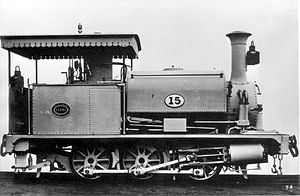
Under the Whyte notation for the classification of steam locomotives, 0-4-0 represents one of the simplest possible types, that with two axles and four coupled wheels, all of which are driven. The wheels on the earliest four-coupled locomotives were connected by a single gear wheel, but from 1825 the wheels were usually connected with coupling rods to form a single driven set.
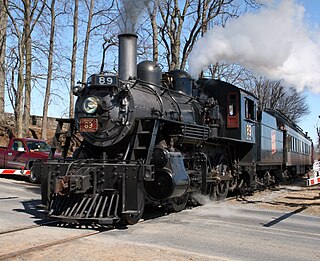
Under the Whyte notation for the classification of steam locomotives, 2-6-0 represents the wheel arrangement of two leading wheels on one axle, usually in a leading truck, six powered and coupled driving wheels on three axles and no trailing wheels. This arrangement is commonly called a Mogul.

The South African Railways Class A 4-8-2T of 1888 is a steam locomotive class from the pre-Union era in the Colony of Natal.

The South African Railways Class H2 4-8-2T of 1909 was a steam locomotive from the pre-Union era in the Colony of Natal.
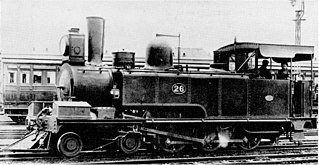
The South African Railways Class C 4-6-0T of 1879 was a steam locomotive from the pre-Union era in the Colony of Natal.

The South African Railways Class C1 4-6-2T of 1901 was a steam locomotive from the pre-Union era in the Natal Colony.

The South African Railways Class C2 4-6-4T of 1896 was a steam locomotive from the pre-Union era in the Colony of Natal.

The South African Railways Class E 4-6-4T of 1902 was a steam locomotive from the pre-Union era in the Colony of Natal.

The Natal Government Railways Class K 2-6-0T of 1877 was a South African steam locomotive from the pre-Union era in the Natal Colony.
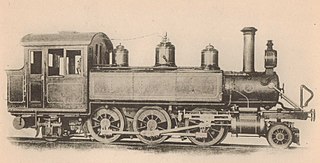
The Natal Government Railways Class I 2-6-2T of 1901 was a South African steam locomotive from the pre-Union era in the Colony of Natal.

The Natal Government Railways Class I 2-6-0 of 1902 was a South African steam locomotive from the pre-Union era in the Colony of Natal.

The Natal Government Railways Class K 0-4-0ST of 1891 was a South African steam locomotive from the pre-Union era in the Colony of Natal.

Durban Harbour's Sir Albert of 1904 was a South African steam locomotive from the pre-Union era in the Natal Colony.

Durban Harbour's John Milne of 1879 was a South African steam locomotive from the pre-Union era in the Colony of Natal.

The Cape Government Railways 1st Class 2-6-0ST of 1876 was a South African steam locomotive from the pre-Union era in the Cape of Good Hope.

The Port Elizabeth Harbour 0-4-0ST of 1894 was a South African steam locomotive from the pre-Union era in the Cape of Good Hope.

The Natal Government Railways Class N 4-6-2T of 1906 was a South African steam locomotive from the pre-Union era in the Natal Colony.
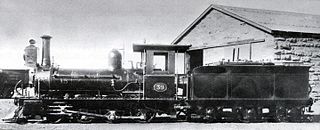
The Cape Government Railways 1st Class locomotives include ten locomotive types, all designated 1st Class irrespective of differences in wheel arrangement or configuration.

The Natal Government Railways Class K locomotives include three locomotive types, all designated Class K irrespective of differences in wheel arrangement.
The South African type SH tender was a steam locomotive tender from the pre-Union era in the Natal Colony.
